Australia news LIVE Sydneys lockdown extended until end of August as NSW records 177 new local COVID-19 cases Victoria restrictions eased
1 of 7
Forty-seven Woolworths supermarkets and 21 Coles locations feature on NSW Health’s growing COVID-19 exposure site list, a data analysis shows.
About 24 per cent - that is, 112 of 467 - of the exposure sites are supermarkets or grocers.
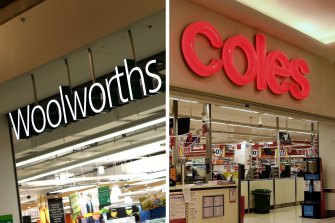
More than 60 exposure sites in NSW are Woolworths or Coles supermarkets.Credit:SMH
There are 47 Woolworths stores, 21 Coles supermarkets, 14 Aldi stores, 12 IGA locations, plus 18 miscellaneous fruit and veg shops. That’s about one in four of the total venues of concern.
Impacted Woolworths sites stretch from Dapto in the Illawarra to as far west as North Orange in the Central Tablelands right up to Glenrose and Dee Why in Sydney’s northern beaches.
Affected Coles stores span from Bondi in the eastern suburbs to Narellan, 60 kilometres south-west of Sydney’s CBD, to San Remo, Wallsend and Lake Haven on the Central Coast.
The supermarkets are a mixture of close contact and casual contact venues, meaning the level of risk varies.
But it shows how many of the exposure sites are the very definition of essential, given everyone needs food for survival.
On Wednesday night, NSW Health issued an alert for three more Woolworths supermarkets - in Liverpool, Ingleburn and Springfarm.
Measures supermarkets have in place to minimise risk include cleaning high-touch areas, providing hand sanitiser and requiring staff members to wear masks.
If you are worried about your exposure, try shopping during an off-peak time or utilise online ordering (pick-up or delivery) where available.
NSW Health’s latest list of COVID-19 exposure sites can be found here.
NSW Health have issued their latest venues of concern, and the list includes a pizza shop in Sydney’s inner west, with tier one (close contact) exposure all day on Saturday at Mancini’s in Belfield.
Anyone who visited these venues at the times listed are considered a close contact:
Engadine, GoVita, 1052 Old Princes Highway, on Wednesday 21 July from 9:45am to 9:55am
Gwynneville, Gwynneville Bakery, 3/168 Gipps Road, on Saturday 24 July from 9am to 9:30am
Belfield, Mancini’s Original Woodfired Pizza, 21 Burwood Road, on Saturday 24 July, all day
The list of 13 casual exposure sites includes venues in the Illawarra, Campsie, Zetland, Summer Hill, The Ponds, Smithfield, Canley Heights, Cabramatta, Lidcombe, Fairfield, Plumpton and Casula:
Campsie, Campsie Centre, 14-28 Amy Street on Friday 23 July and Saturday 24 July, all day
Bellambi, Bunnings, Corner Bellambi Lane and Watts Lane on Tuesday 20 from July 11am to 11:15am
Zetland, Coles East Village, O’Dea Avenue, on Sunday 25 July from 4pm to 4:30pm
The Ponds, Costis Seafood and Grill, The Ponds Shopping Centre, 101 The Ponds Boulevard on Saturday 24 July from 4:05pm to 4:15pm
Smithfield, Bunnings Smithfield, Corner Cumberland Highway and Stuard Highway on Saturday 24 July from 3:30pm to 4pm
Canley Heights, Carter Gs Coffee Shop, 199 St Johns Road on Wednesday 21 July from 7:40am to 7:50am
Cabramatta, Accounting Dynamics, Level 1, Office 4/90 John Street on Tuesday 27 July on 4:20pm to 7:30pm
Fairfield, Woolworths Fairfield Heights, 1/29 Court Road on Friday 23 July from 7:30pm to 8pm
Lidcombe, Bunnings Warehouse Lidcombe, 23-29 Parramatta Road on Friday 23 July from 2:15pm to 3:15pm
Lidcombe, Woolworths Lidcombe, 92 Parramatta Road, on Friday 23 July from 3:30pm to 4:30pm
Plumpton, Woolworths Plumpton, 260 Jersey Road on Sunday 25 July from 1:30pm to 1:50pm
Summer Hill, Summer Hill Newsagent, 4 Lackey Street on Saturday 17 July from 8am to 9am, and Wednesday 21 July from 8am to 9am
Casula, Coles Casula, Kurrajong Road on Saturday 17 July from 12:10pm to 1:30pm
Infectious disease and health experts say Queensland’s run of 13 separate cases of community COVID-19 exposure in less than two months â€" so far without widespread transmission â€" were largely a matter of luck that could turn at any time, as seen in Sydney.
With many of the 13 cases stemming from hotel quarantine, Chief Health Officer Jeannette Young used some of her strongest language yet on Wednesday to describe the hotels as “completely insufficient†to contain the more infectious Delta variant, and to call for change.
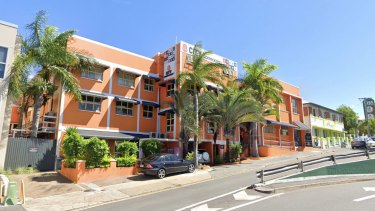
City Backpackers on Upper Roma Street is one of two hostels added to the list of possible exposure sites on Wednesday.Credit:Google Street View
One new locally acquired infection was reported on Wednesday from more than 17,000 tests â€" a West Australian man who had returned from the Philippines and completed two weeks of quarantine at Brisbane’s Quest hotel before his release on July 17 following three negative tests.
He had since been staying at City Backpackers on Upper Roma Street before becoming unwell, visiting the Royal Brisbane and Women’s Hospital emergency department late on Monday, and returning a positive test on Tuesday night.
The man was deemed to be infectious in the community since July 22. Contact tracers have so far identified only the hostels, hospital, and nearby taxi rank as new exposure sites.
Both the City Backpackers and neighbouring Joe’s Place hostel remained in lockdown and cordoned off with police tape on Wednesday night as guests awaited their test results.
Read more here
Public health officials and epidemiologists say the discovery of a new community case of coronavirus in Victoria is concerning and even the best-case scenario of the man having caught the virus working at a testing station poses significant challenges.
The traffic controller is believed to have worked at the Moonee Valley Racecourse drive-through testing site for two days while infectious, before becoming the ninth locally acquired case of coronavirus reported in the state on Wednesday. The other eight cases were all linked to known clusters and were in isolation for their entire infectious period.
The case emerged as organisers of this year’s Royal Melbourne Show announced they would be cancelling the event for the second consecutive year.
Epidemiologists say it will be critical to establish how the man picked up the infection, saying even if he acquired it at work from someone getting a COVID-19 test, there was the danger he could have passed it onto his workmates and others including those visiting the testing station.
Deakin University epidemiology chair Catherine Bennett said there was a more worrying possibility, albeit a smaller one, that the man picked up the virus in the community from someone yet to be discovered by authorities.
“Unfortunately, both scenarios are not good,†she said.
Read more here
NSW Health has released the latest list of venues of concern, with tier one exposure sites including a Roselands petrol station and Central Coast bus routes.
Anyone who attended, or travelled on, the following venues and bus routes at the times listed is a close contact and must get tested and isolate for 14 days:
Roselands, Caltex Woolworths, 218 King Georges Road on Monday 26 July from 3:10pm to 3:20pm
Route 25, From Tuggerah Station to Bateau Bay Square on Friday, 23 July from 1.58pm to 2.35pm
Route 21, From Lions Park, Central Coast Highway, Long Jetty to Gosford Train Station, Stand N, Friday, 23 July from 3:41pm to 4:30pm
Viral fragments of COVID-19 have been detected in sewage in central-western NSW, at a sewage treatment plant in Molong less than 24 hours after the region was lifted out of lockdown.
NSW Health said it was aware of one COVID-19 case in Molong, but the case does not live within the sewage plant’s catchment area.
The region was locked down for a week last Wednesday, after a truck driver from Sydney infected a worker at a pet food factory in nearby Blayney. That lockdown lifted overnight.
In a statement, NSW Health said it is “concerned that the detection could signal undetected cases in the community and asks people in these areas to be alert for any symptoms that could signal COVID-19, including sore throat, runny nose, cough, fever or headache.
“If symptoms appear, please isolate and get tested immediately, and remain isolated until a negative result is received.“
For the full list of exposure sites, see the tweet below:
The Royal Melbourne Show has announced the cancellation of their event for the second year running, blaming the “ongoing uncertainty and operational constraints†attached to holding major events during the pandemic.
“The 2021 Royal Melbourne Show has been cancelled due to the ongoing uncertainty and operational constraints, challenges and risks associated with holding major events with large free-roaming crowds during the COVID-19 pandemic,†the show said in a statement.
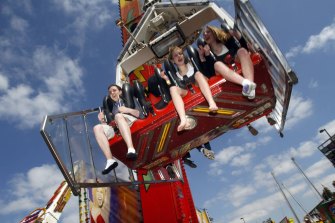
The Royal Melbourne Show has been cancelled - again.Credit:Luis Enrique Ascui
The show was scheduled to be held over 11 days from September 23 to October 3 at Melbourne Showgrounds.
Royal Agricultural Society of Victoria president Matt Coleman said: “The Royal Melbourne Show is a much-loved major Victorian event that is a unique and valuable platform to promote and celebrate excellence in agriculture, with thousands of agricultural producers from rural and regional Victoria coming together at Melbourne Showgrounds.â€
The show is Victoria’s largest annual community event, attracting 450,000 visitors over 11 days each year. The show says they contribute more than $244 million in value to the Victorian economy on an annual basis.
Federal Treasurer Josh Frydenberg has defended the federal government’s forward-planning for COVID lockdowns, saying coronavirus has “morphed and changed†over time.
Mr Frydenberg, the member for Kooyong, was grilled by ABC Radio Melbourne host Rafael Epstein on Wednesday evening on why the treasury didn’t anticipate four-week lockdowns.
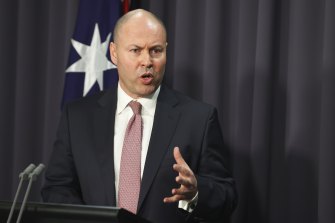
Josh Frydenberg believes short, sharp lockdowns will become more common.Credit:Alex Ellinghausen
“The expectation and assumption that we put in our Budget numbers was for a lockdown, probably a week duration once a month, and what we’ve seen is more than that,†Mr Frydenberg said.
“But we’ve moved pretty quickly. I mean, we have put in place now these income support payments, with about one million payments already processed at a cost of about half a billion dollars.â€
Epstein put to the Treasurer that he didn’t think all the lockdowns were necessary - he thought state governments were using them too often - and that’s why he didn’t have a plan.
“Well, the virus has morphed and changed and there’s been different variants and now we’re dealing with the Delta variant, which is more contagious and also more dangerous,†Mr Frydenberg said.
“I think what is now the accepted wisdom is that shorter, sharper lockdowns like we’ve seen in Victoria over the last couple of weeks have been effective - the same has taken place in South Australia with both states now coming out of lockdown.â€
Mr Frydenberg said that in NSW, “they certainly didn’t move as effectively as they did here in Victoria and South Australiaâ€. He said going forward, he anticipated more shorter, sharper lockdowns in response to coronavirus outbreaks.
The Australian government is working with Qantas to organise a flight for expats stranded in Indonesia, with nearly 800 registered as wanting to return home from a country that is now the global epicentre of the virus.
A spokesperson for Australia’s Department of Foreign Affairs and Trade said on Wednesday it was “looking at all available options to assist vulnerable Australians in Indonesia to returnâ€.
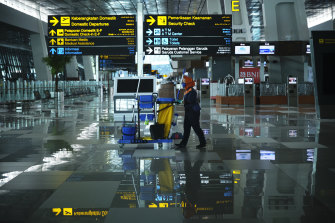
Soekarno-Hatta International Airport in Jakarta has been far less busy during the pandemic.Credit:Getty Images
“We are working with Qantas on an option for a facilitated commercial flight for vulnerable Australians departing from Indonesia,†the spokesperson said.
“Around 780 Australians (including citizens and permanent residents) in Indonesia are currently registered with the Department of Foreign Affairs and Trade as wanting to return and approximately 350 of these are considered vulnerable. The number of Australians registered changes frequently according to people’s circumstances.â€
Read more here.
AstraZeneca’s COVID-19 shot did not increase the instances of rare blood clots with low platelets in people after the second dose, a study showed on Wednesday, potentially easing some worries over the vaccine’s side-effects.
Data published in the Lancet medical journal found that the estimated rate of thrombosis with thrombocytopenia syndrome (TTS) after the second dose of the vaccine was 2.3 per million in those inoculated, comparable to the typical rate seen in those who have not been vaccinated.
That rate was 8.1 after the first dose, it added.
The research, led and funded by AstraZeneca, evaluated reported cases occurring within 14 days of administration of the first or second dose as of April 30 this year, using the Anglo-Swedish drugmaker’s global safety database.
AstraZeneca’s shot, invented by Oxford University, has fallen behind in the vaccine race after several blows, including production delays, a lawsuit and possible links to some rare, but severe side-effects, including TTS, that are being probed by regulators.
The European Union’s drug regulator has been looking into cases of TTS since March and has also found a possible link to Johnson & Johnson’s single-dose shot. It has, however, maintained that overall benefits of both the vaccines outweigh any risks posed by them.
Reuters
The federal health department has released new data that breaks down the current vaccination rates of every five-year age bracket in each state or territory.
We’ve turned the information into a graph, which you can view below. Simply select your state or territory from the menu to see the percentage of each age group that has received at least one COVID-19 vaccine dose.
You can view the latest vaccine rollout data from Australia and around the world in our vaccine tracker data centre, which is updated every day.
Forty-seven Woolworths supermarkets and 21 Coles locations feature on NSW Health’s growing COVID-19 exposure site list, a data analysis shows.
About 24 per cent - that is, 112 of 467 - of the exposure sites are supermarkets or grocers.

More than 60 exposure sites in NSW are Woolworths or Coles supermarkets.Credit:SMH
There are 47 Woolworths stores, 21 Coles supermarkets, 14 Aldi stores, 12 IGA locations, plus 18 miscellaneous fruit and veg shops. That’s about one in four of the total venues of concern.
Impacted Woolworths sites stretch from Dapto in the Illawarra to as far west as North Orange in the Central Tablelands right up to Glenrose and Dee Why in Sydney’s northern beaches.
Affected Coles stores span from Bondi in the eastern suburbs to Narellan, 60 kilometres south-west of Sydney’s CBD, to San Remo, Wallsend and Lake Haven on the Central Coast.
The supermarkets are a mixture of close contact and casual contact venues, meaning the level of risk varies.
But it shows how many of the exposure sites are the very definition of essential, given everyone needs food for survival.
On Wednesday night, NSW Health issued an alert for three more Woolworths supermarkets - in Liverpool, Ingleburn and Springfarm.
Measures supermarkets have in place to minimise risk include cleaning high-touch areas, providing hand sanitiser and requiring staff members to wear masks.
If you are worried about your exposure, try shopping during an off-peak time or utilise online ordering (pick-up or delivery) where available.
NSW Health’s latest list of COVID-19 exposure sites can be found here.
1 of 7
0 Response to "Australia news LIVE Sydneys lockdown extended until end of August as NSW records 177 new local COVID-19 cases Victoria restrictions eased"
Post a Comment